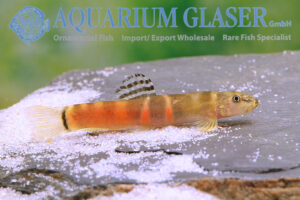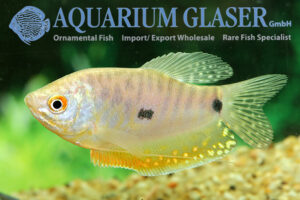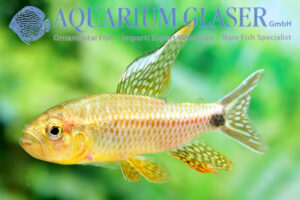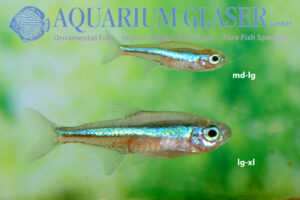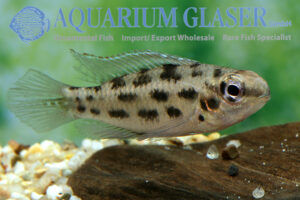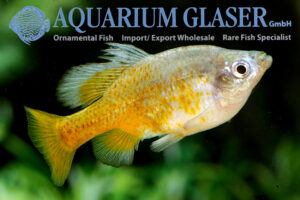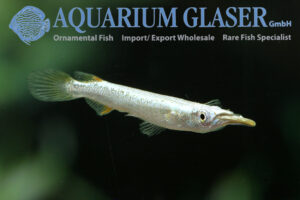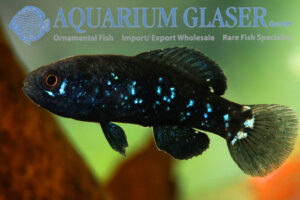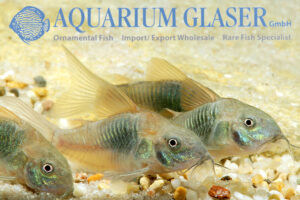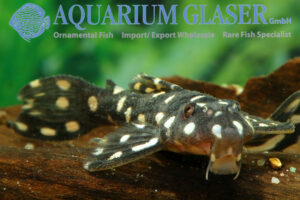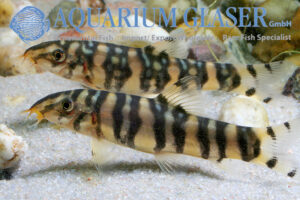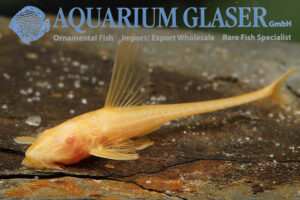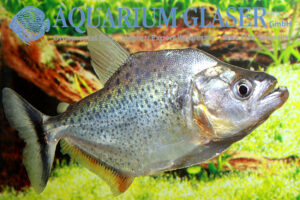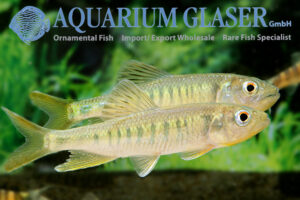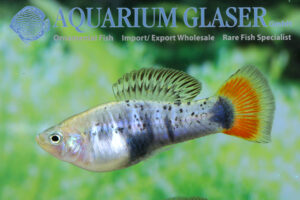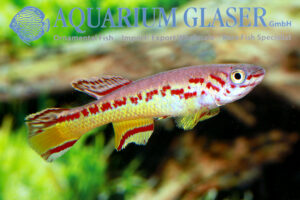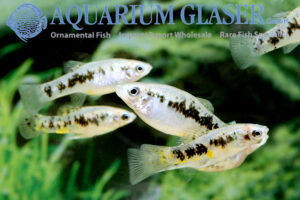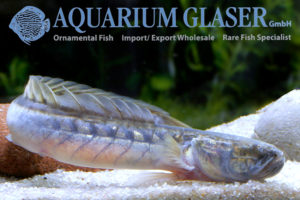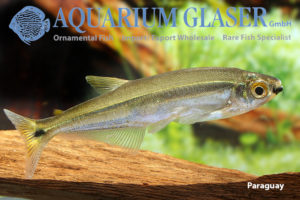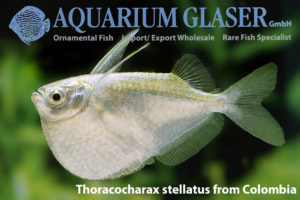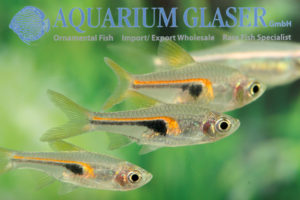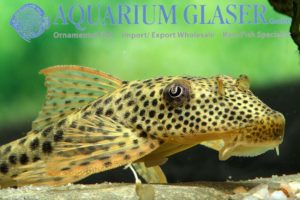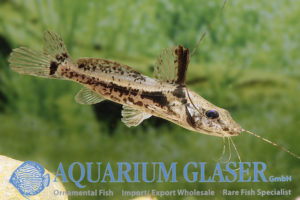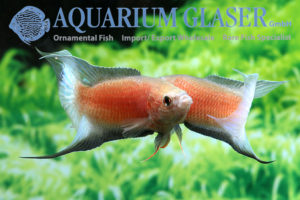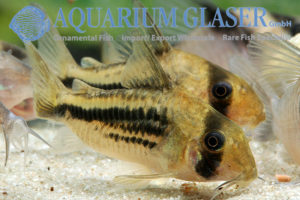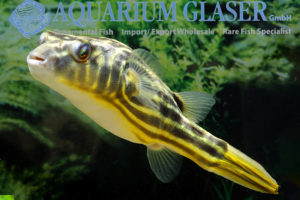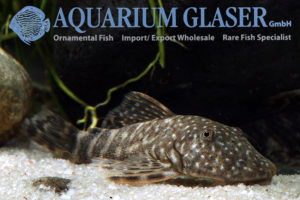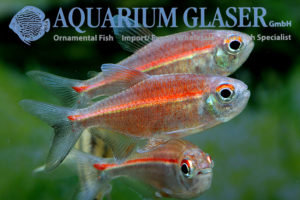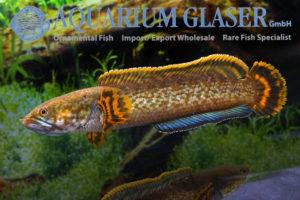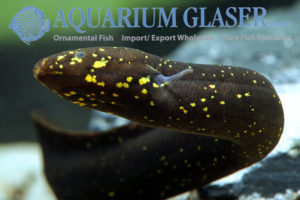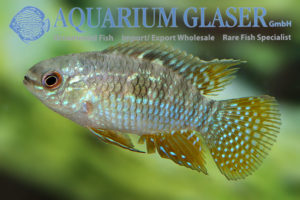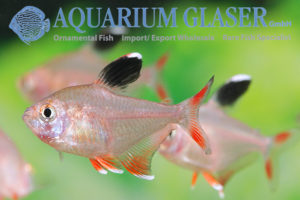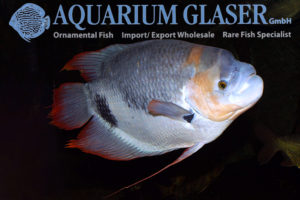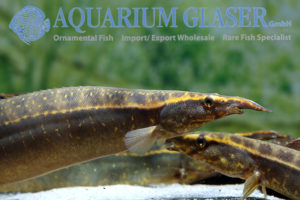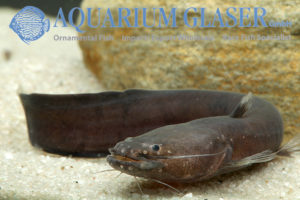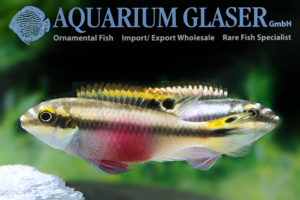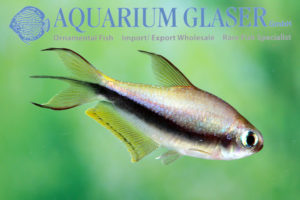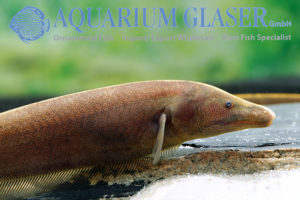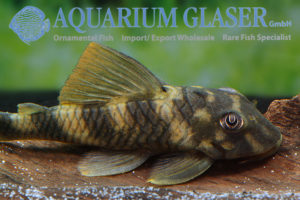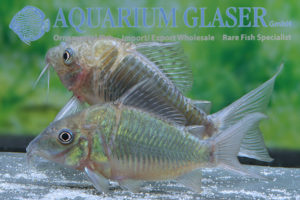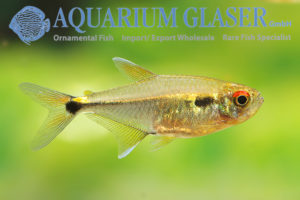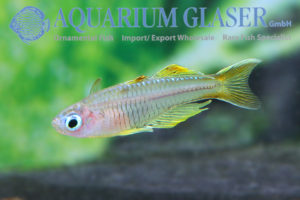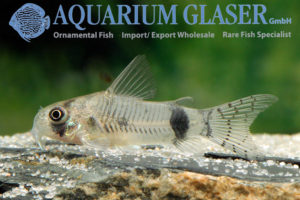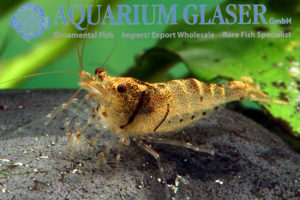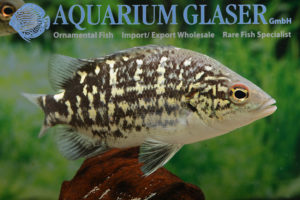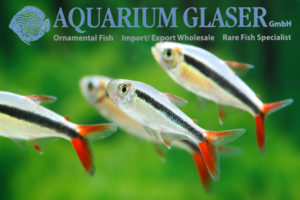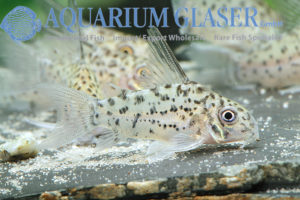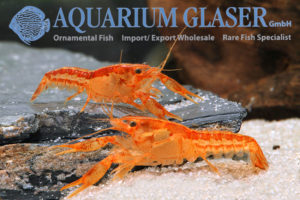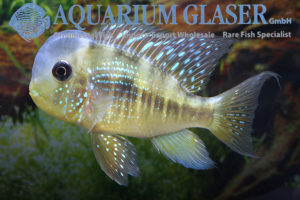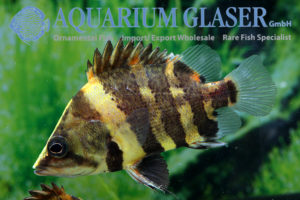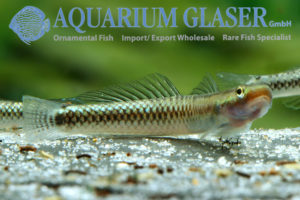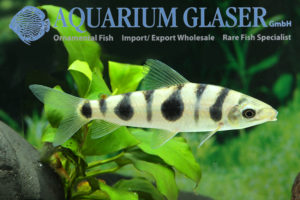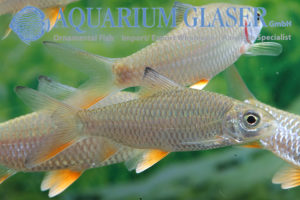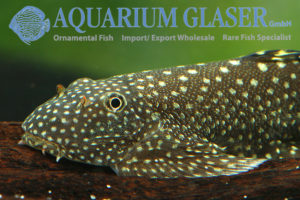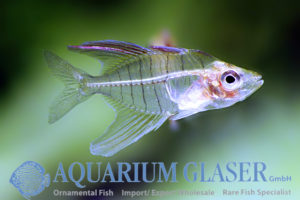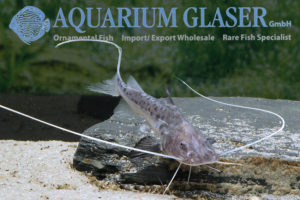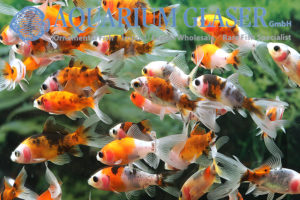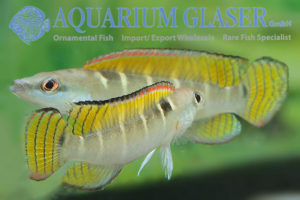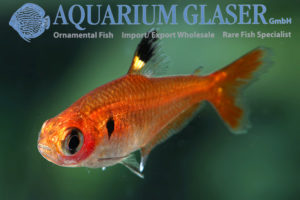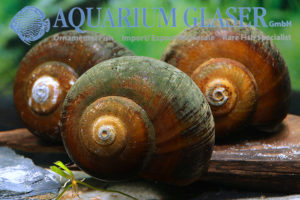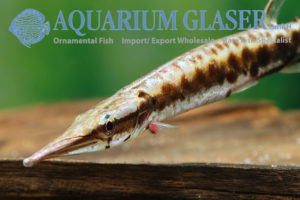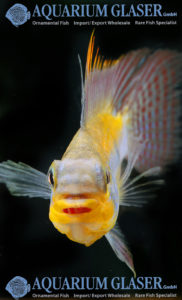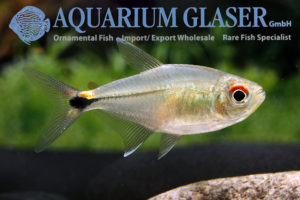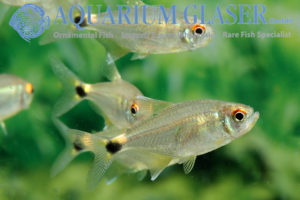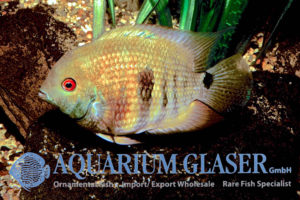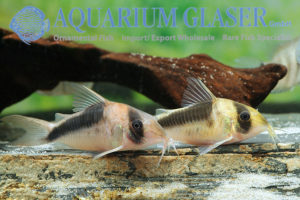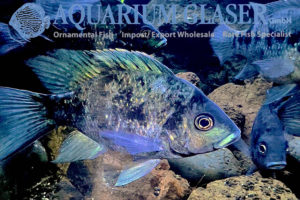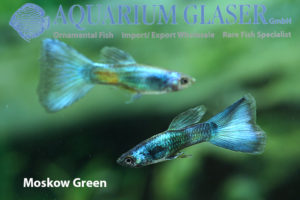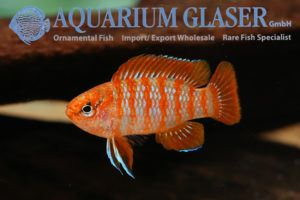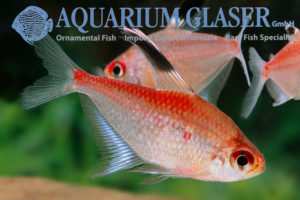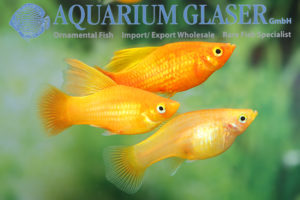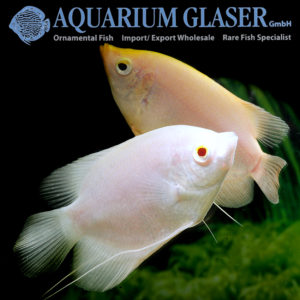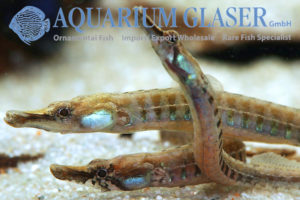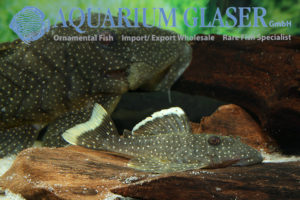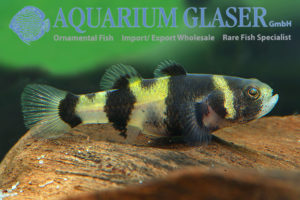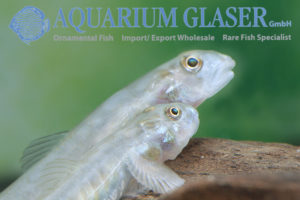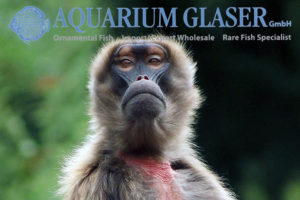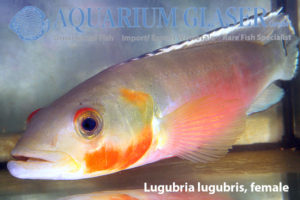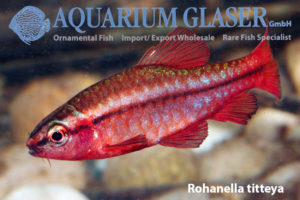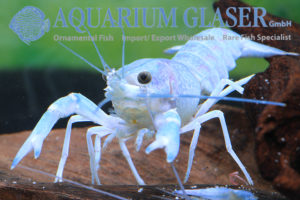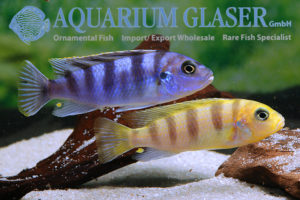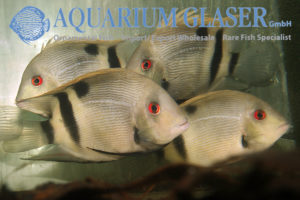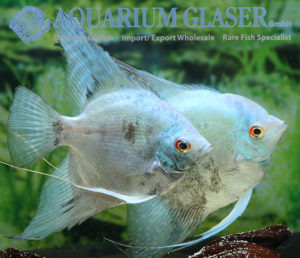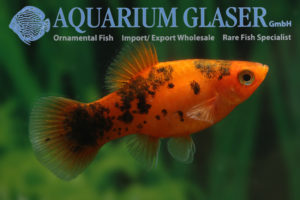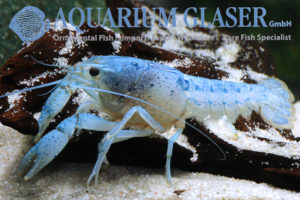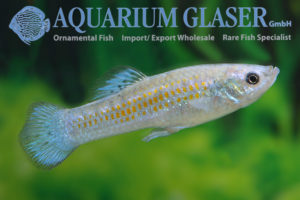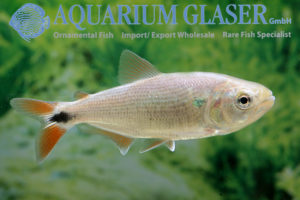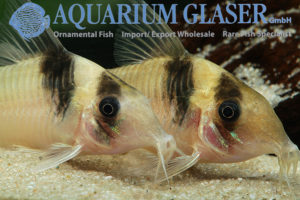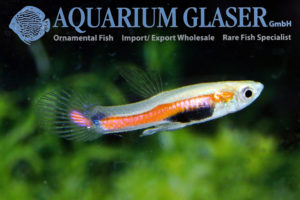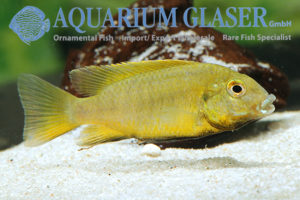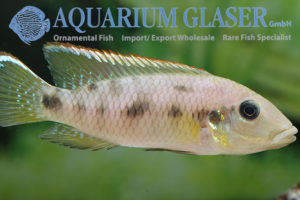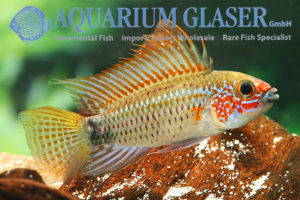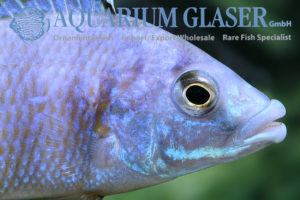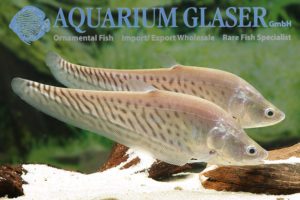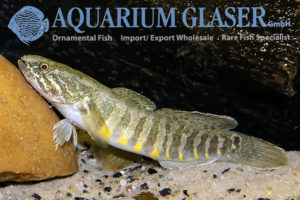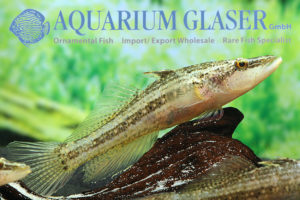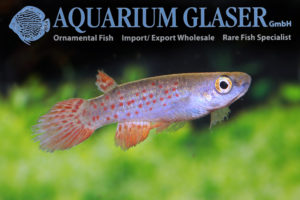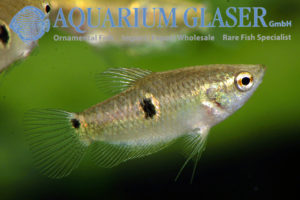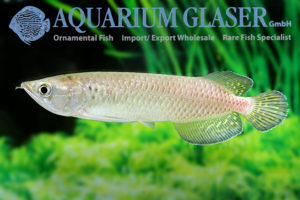There are a large number – over 300, of which over 200 are considered valid species – of scientifically described Schistura species; only very few of these have found their way into aquaria to date. One of the most beautiful is the species previously known as Schistura cf. balteata from Thailand, which was recently (October […]
Fish Archive (2963)
-
-
Trichogaster trichopterus ( = Trichopodus t.)
The spotted gourami is one of the most important ornamental fish of all and is one of the top 100 worldwide. The species is extremely widespread in Southeast Asia. Despite its relatively small size (usually 8-10, rarely up to 15 cm), this gourami is used as a food fish and can survive for a long […]
-
Crenuchus spilurus
Crenuchus spilurus is the only formally described species of the genus Crenuchus. There is, of course, at least one other species in Venezuela (see https://www.aquariumglaser.de/en/09-characoids-tetra-relationship/a_new_species_of_crenuchus__en/). C. spilurus was originally described from the Essequibo River in Guyana. We have now once again received extremely beautiful specimens from Manaus (Brazil). In contrast to almost all other tetras, […]
-
Paracheirodon simulans lg-xl
The internationally since always Green Neon, in German also occasionally Blue Neon (to avoid confusion with Hemigrammus hyanuary, which is also called Green Neon) called Neon tetra Paracheirodon simulans we have more or less always in our assortment, see https://www.aquariumglaser.de/en/09-characoids-tetra-relationship/paracheirodon-simulans-2/ Now we have received from our supplier in Colombia comparatively extremely large specimens, as we […]
-
Dicrossus warzeli Bred
The rarest of all checkerboard cichlids in the aquarium is Dicrossus warzeli, which was known as Dicrossus or Crenicara sp. Tapajós before its scientific description. In 1992 the very characteristically marked dwarf cichlid was discovered in an unnamed tributary (Igarapé) of the great Rio Tapajós in Brazil by the traveling aquarist Frank Warzel and brought […]
-
Skiffia francesae
Every year in autumn we receive the “harvest” of the season from our goodeid breeders. Because of the extraordinarily long and mild summer, this year it was the end of October. As is well known, it does these fish extremely good in permanent breeding if they are temporarily maintained and bred under outdoor conditions. However, […]
-
Dermogenys siamensis Silver-White (D. pusillus)
There is a silver-white breeding form of Dermogenys siamensis (in the hobby usually called D. pusillus or D. pusilla, but this is a different species, which is not kept in the aquarium), in which – similar to the gold tetras – shiny color pigment (guanine) is produced in excess in the skin cells. In nature […]
-
Elassoma evergladei
The Pygmy Sunfish, Elassoma evergladei, is a classic dwarf fish and has been maintained and bred for many generations of aquarists. The species is best housed in a small species aquarium that does not require heating. The cute fish, growing only 2-3 cm, are completely peaceful, however the males defend an individual area against conspecifics. […]
-
Corydoras sp. aff. aeneus “CW26”
The Bronze Corydoras, Corydoras aeneus, is – this may be surprising – very poorly researched. We know armored catfishes that roughly correspond in appearance to C. aeneus from practically all of South America, we also know the appearance of animals from Trinidad (the place from which C. aeneus was scientifically described). We know that Bronze […]
-
Scobinancistrus raonii L82 ( = “Scobinancistrus sp. Orange Spot”)
The beautiful L82 originates from the lower Rio Xingu in Brazil (around Altamira). The species is very variable in terms of spot size and shape. Wild-caught specimens also often have a yellowish-orange spot coloration or shiny green-blue spots (“Opal-Pleco”). A few days ago (on October 30, 2023), the species, which received its L-number back in […]
-
Botia rostrata
To say it right away: nobody knows exactly which species of loach is hidden behind the name Botia rostrata from a scientific point of view. But this is not the right place to discuss such things. Especially interested people are referred to the very detailed work of Steven Grant (2007). The loach we present here […]
-
Rineloricaria lanceolata “Albino“
Albinism, i.e. the complete or partial absence of black color pigments in the body cells, occurs widely as a mutation in the animal kingdom. While albinos rarely survive in the wild because of their striking light color, they are particularly popular in commonly bred animals. On many people albinos seem very attractive. The species Rineloricaria […]
-
Serrasalmus irritans
Serrasalmus irritans is a slender piranha, described by the first describer Peters in 1877 as follows: “The area above the lateral line spotted black-blue. The caudal fin with a broad black-blue band enclosing the middle of the base, the broad margin yellow-white; the anal fin reddish, black at the margin. A specimen, 17 centimeters long, […]
-
Opsariichthys cf. songmaensis
From Vietnam we were able to import dragonfishes, which we first – at a superficial view – thought to be Zacco platypus. Then we looked a little bit closer and there were differences. First of all Zacco platypus has clearly wider body bands. So we started to do some research and that’s when it got […]
-
Xiphophorus variatus Rio Coacuilco (2)
About half a year ago we introduced this new variety of the wild form of the variable platyfish (https://www.aquariumglaser.de/en/18-toothcarps-killis-and-livebearers/xiphophorus-variatus-rio-coacuilco-2/). Now we have received the next generation of offspring from our breeder. This time we were lucky and an alpha male already formed with us. The alpha male is the dominant male within the social structure […]
-
Fundulopanchax amieti
Once again we have received Amiet´s Lyretail. Fundulopanchax (formerly: Aphyosemion) amieti is a magnificent, easy to care for and peaceful killifish. Our animals are German offspring. Originally the species comes from tropical Africa, the southwest of Cameroon (Sanaga system). Killifishes are generally considered to be fish for specialists, which live only a short time and […]
-
Limia vittata
We receive a very charming lifebearer from a breeder from Thailand: Limia vittata. This species, which originally comes from Cuba, has been known aquaristically for a long time: the first import date is 1913. In the hobby, however, the animals are only sporadically available. That is hardly to be understood, because each animal has an […]
-
Gobioides broussonnetii
Only rarely we can offer the dragon fish, Gobioides broussonnetii, which actually is a species of goby. Now we received once again from Colombia this strange bottom dweller. The maximum length of the species is said to be about 40 cm. They are absolutely peaceful plankton eaters, which should be offered fine sandy substrate in […]
-
Piabucus melanostoma
From Paraguay we received large (10-12 cm), unusual tetras. These elegant animals can be assigned without problems to the genus Piabucus, which according to current knowledge includes three species. Two of them are supposed to occur also in Paraguay, namely P. dentatus and P. melanostoma. In the past, it was thought that the two species […]
-
Thoracocharax stellatus
The platinum hatchetfish, Thoracocharax stellatus, is one of the more commonly imported yet mysterious species within the hatchetfish family. It appears to have an extremely wide distribution in South America. Scientific evidence exists from Argentina, Bolivia, Brazil, Colombia, Uruguay, Ecuador, Paraguay, Peru and Venezuela. So, regardless of state boundaries, these are the Paraguay/Paraná, Amazon and […]
-
Trigonostigma hengeli
Currently there are 5 species of harlequin barbs (Trigonostigma) scientifically named and accepted: the “classic” harlequin barb (T. heteromorpha), plus T. hengeli, T. espei, T. somphongsi and T. truncata. However, genetic studies showed that there are even more species. An exciting topic! From the great Sunda Islands of Sumatra and Borneo comes the glowlight harlequin […]
-
Squaliforma cf. emarginata L11
Among the loricariid catfishes that are known by scientists for a very long time already is this species. It has been described initially 1840 under the name of Hypostomus emarginatus. Since then it has been placed in different genera, in 2001 in Squaliforma and in 2016 in Aphanotorulus, when Squaliforma has been considered to be […]
-
Goeldiella eques
From Peru we could import this interesting catfish, which is only rarely available, although the species has a very wide distribution in South America. The up to 30-35 cm long fish has already been reported from the whole Amazon region and from the Guyana countries. Zoologically Goeldiella eques belongs to the family Heptapteridae; there are […]
-
Macropodus opercularis: squeaky red!
Solid red paradise fishes (Macropodus opercularis) have been known since the 1990s. However, they could not really establish themselves in the market, because the animals, which were also traded under the fancy name “Macropodus rex”, turned out to be very susceptible to diseases. Apparently the problem has been solved and we have now received really […]
-
Corydoras axelrodi (“deckeri”)
Since many decades Corydoras catfishes are sold from Colombia under the fancy name “Corydoras deckeri”. Where this name comes from is not documented, probably there was once an exporter named Decker, but nobody knows about him today. The “Corydoras deckeri” come from the Rio Meta. Behind the name there are four different Corydoras species: Corydoras […]
-
Dieter Bork (1945 – 2023)
When the news reached us last Wednesday, 27.9.2023, that Dieter Bork had died, it was a shock. We had just met in the fish hall of Aquarium Glaser, he was as lively as ever, full of plans and ideas, anything but frail. It still seems inconceivable to me that he will never again tell us […]
-
Tetraodon lineatus 15-20 cm
The very first puffer fish to receive a scientific name valid in today’s sense was the Nile puffer fish, Tetraodon lineatus. This was in 1758 and is not at all surprising, because the scholars of the world knew the fish since ancient times. In ancient Egypt there was even a hieroglyph in the form of […]
-
Chaetostoma dorsale (L147, L443)
The bristlemouth catfish (Chaetostoma) are an exceptionally diverse genus of suckermouth armored catfishes. According to Fishbase (2023), 47 species are currently considered valid. From Colombia, more precisely from the surroundings of the city of Villavicencio, the capital of the department of Meta, Chaetostoma have been exported for decades as common “bread-and-butter fish”. However, it was […]
-
Hemigrammus coeruleus
Although Hemigrammus coeruleus has a very wide distribution in Amazonia (Brazil, Ecuador, Colombia) and was scientifically described as early as 1908, it only entered aquariums in the early 2000s (at least recognized). H. coeruleus is a fish with two faces: in neutral mood it is pretty, but not spectacular and looks like a mixture of […]
-
Channa brunnea
The Rainbow Snakehead (Channa bleheri) is without doubt one of the most beautiful and colorful snakeheads and with usually 12-15 cm total length (sometimes a bit more) it stays quite small. It originates from the north of India and belongs to the few Channa species without ventral fins. Since 2007 a very similar, also colorful […]
-
Lepidosiren paradoxus
The South American Lungfish is a very interesting fish, but it has only very drab colours. The usual pattern is mudcolour, eg brownish, greyish, sometimes a bit blackish. But why should an animal that lives in swamps and feeds on snails show bright coloration? On the other hand: astonishingly enough, very young specimens, like the […]
-
Laetacara curviceps
Long before the Apistogramma species became popular, another dwarf cichlid from Brazil captured the hearts of aquarists: Laetacara curviceps, the Flag acara. At that time it was still called Aequidens curviceps. For some time it has unfortunately become quiet around him. Now we have once again received beautiful offspring of this small, peaceful and beautiful […]
-
Hyphessobrycon rosaceus (“ornatus”)
In 1997, the US ichthyologists Stanley Weitzman and Lisa Palmer published a scientific paper that caused a sensation among experts. In it, they described the new species Hyphessobrycon epicharis, but also commented in detail on a relationship group within the South American small tetras known as the “rosy tetra clade”. The authors showed, among other […]
-
Osphronemus laticlavius
Once again we received the rare red-finned giant gourami (Osphronemus laticlavius). Like the common giant gourami this species grows around 60 cm long. The home of the fish is on Borneo, where it probably occurs naturally only in Sabah, i.e. in the very north of the island in the Malayan part. Since about 1985 this […]
-
Macrognathus aculeatus “Bangka”
The small spiny eel Macrognathus aculeatus – the species rarely grows to 20 cm long, even though 38 cm is given as the maximum length in the literature – is one of the longest known species of these bizarre fishes. Already in 1786 it was described by Bloch. As so often with old known species […]
-
Myoglanis koepckei
This small catfish, unique in its combination of characteristics, originates from Peru. There it was collected (scientifically) for the first time in 1984 in a small tributary of the Rio Nanay, which had sandy bottom covered with debris (probably dead wood, dead leaves etc). The scientific description was then in 1999 as Myoglanis koepckei. In […]
-
Pelvicachromis pulcher wild yellow
The yellow color variety of the species P. pulcher comes from southwestern Nigeria, where it is collected west of the Niger Delta in the Ethiop River area. The additional color designations yellow, red and green refer to the gill covers in P. pulcher, they all get red bellies. In all Pelvicachromis, females are considerably more […]
-
Nematobrycon palmeri WILD
The Emperor Tetra (Nematobrycon palmeri) has been one of the most popular tetra species for decades due to its beauty and interesting behavior, and is available year-round as a captive breed. Wild catches, on the other hand, are only available for a limited time and on a seasonal basis. We have now once again received […]
-
Apteronotus leptorhynchus (A. macrostomus)
The “Brown Ghost” is one of the most popular knifefishes in the aquarium. The species is not small, but not huge either: the maximum length to be expected is about 20 cm. This makes it less than half the size of its black cousin (A. albifrons). It is fascinating to observe knifefish in the aquarium. […]
-
Peckoltia sp. L265/LDA84
There are three forms of orange fringed plecos among L catfishes, namely L76 (tributaries of Rio do Pará, Brazil), L99 (also tributaries of Rio do Pará, Brazil), and L265 (Rio Tajajós and its tributary Rio Jamanxin, Brazil). Thus, all sites are located within the state of Pará. L265 has also received LDA number 84 after […]
-
Brochis splendens “Peru“
From the upper Amazonas drainage in Peru we regularly receive the beautiful emerald catfish, Brochis splendens. From this region no less than four synonyms of this armored catfish, distributed in three genera (Brochis, Chaenothorax and Corydoras) were described by the famous biologist Edward Drinker Cope (1840-1897)! This shows very clearly how different the fish can […]
-
Hemigrammus luelingi
Head-and-Taillight tetras were introduced to Germany as early as 1910 and were also bred soon after. They soon belonged to the iron stock of ornamental fish. Since then there are practically no more wild-caught imports. Now we have received head-and-taillights from Peru, which we initially mistakenly determined to be wild Hemigrammus ocellifer. Tetra specialist Flávio […]
-
Pseudomugil ivantsoffi
This cute blue-eye originates from the surroundings of the town Timika in the Indonesian province Papua on New Guinea. It was discovered and scientifically described relatively late (1999); at first it was thought to be the same species as P. reticulatus, whose locality is about 900 km further northwest (seen from Timika). But then it […]
-
Corydoras ortegai (CW31)
This cute corydoras is relatively new. It was scientifically described only in 2007. In the hobby it was known a bit longer as “Loreto Panda”, “New Panda” and under the code number CW31. The CW-numbers are assigned on the homepage of Ian Fuller (https://www.corydorasworld.com/). The complete distribution of the pretty species is not yet known. […]
-
Caridina pareparensis parvidentata
Dwarf shrimp from the island of Sulawesi (formerly: Celebes) in Indonesia are famous for their colorfulness – and notorious for their high demands on care. These species originate from the large Malili lakes. However, there are dwarf shrimp on Sulawesi that are some of the easiest to keep and maintain anywhere! Among these is Caridina […]
-
Hephaestus habbemai
New fish, new questions. This is how we could characterize our import of the grunter Hephaestus habbemai. These beautiful fish come to us from Indonesia and originate from the island of New Guinea. Originally (1910) they were described from the south of the island, from the Lorentz River. The species is a pure freshwater inhabitant; […]
-
Thayeria sp. Red Tail Teles Pires
Penguin tetras (Thayeria) are well known aquarium fishes. Of the scientifically accepted four species (T. boehlkei, T. ifati, T. obliqua, T. tapajonica) T. boehlkei is always on offer in the ornamental fish trade. Almost all of them are offsprings, although the species is widely distributed in South America (Peru, Ecuador, Brazil and Bolivia). The Rio […]
-
Corydoras loretoensis
The extremely great popularity of the Corydoras in aquaristics is certainly due to the combination of peacefulness, usefulness and nice appearance that these fish combine. They all have these characteristics, and so you really can’t go far wrong when it comes to deciding which species to choose for your aquarium. But there are subtle differences […]
-
Cambarellus patzcuarensis CPO
The gray-brown wild form of the orange dwarf crayfish Cambarellus patzcuarensis (CPO) originates from Mexico, where it is endemic (i.e. only found there) in Lake Patzcuaro. Due to massive environmental pollution and the use of foreign fish for food purposes, the ecosystem of Lake Patzcuaro is extremely disturbed, and a large number of the animal […]
-
Gymnogeophagus balzanii
The hump of the male of G. balzanii is comparable to the feather tail of a peacock: it is simply the expression of manhood! The Paraguay Eartheater originates from the southern parts of South America and is imported now and then from Paraguay as wild collected stock, but the species is also bred on a […]
-
Datnioides campbelli
Among lovers of large, predatory fish, the species of the genus Datnioides (formerly: Coius) enjoy great popularity. They are calm, expressive fish that, after a sometimes somewhat tough acclimation period in which they are shy and skittish, become very attached to the keeper and provide decades of enjoyment. All Datnioides species grow to 30-40 cm […]
-
Stiphodon atropurpureus
The neon gobies of the genus Stiphodon are all beautiful fish. None of the 37 currently known species grows longer than 5-7 cm, usually they remain much smaller. Although adult Stiphodon live exclusively in pure freshwater, the larvae can only develop in the sea. Therefore, neon gobies live in streams near the coast. They spawn […]
-
Leporinus pellegrinii
The large genus Leporinus comprises more than 90 species and still confronts science with hardly solvable problems concerning the delimitation of the species. Among the groups of species known for decades as particularly complicated is the group of forms around Leporinus maculatus. These are Leporinus, where at least a part of the flank pattern consists […]
-
Hypselobarbus jerdoni
We have received again some juveniles of the very rarely imported large barb Hypselobarbus jerdoni. It is an endemic species of southern India, where it is found in the states of Karnataka and Kerala. With a maximum final length of 50 cm, H. jerdoni is only suitable for really large aquariums. Here the current-loving, peaceful […]
-
Gastromyzon “punctulatus”
In 1961, a review paper on the hillstream loaches of the genus Gastromyzon of Borneo was published. In it five species were distinguished: G. pauciradiatus, G. nieuwenhuisii, G. fasciatus, G. punctulatus and G. borneensis. In 2006 the next revision of these fishes from Borneo appeared. This was accompanied by a true species explosion; in Gastromyzon […]
-
Gymnochanda ploegi
We have received this dwarf glass perch from Indonesia, which was named in honour of Alex Ploeg, who was in the passenger plane shot over the Ukraine on 17 July 2014. Gymnochanda ploegi is known so far only from West Kalimantan, the part of Borneo belonging to Indonesia. It is a pure freshwater species that […]
-
Brachyplatystoma capapretum
The genus Brachyplatystoma is called “Goliath Catfishes” in English, because some of its species belong to the largest freshwater fishes at all: up to 3.6 m length are given in literature! In South America they are ubiquitous and important food fish, of which more than 30,000 tons are consumed annually. Nevertheless, distinguishing the species is […]
-
Carassius auratus Shubunkin multicolored 4-6 cm
The juveniles of all goldfish breeds are wild colored up to a length of about 4 cm, i.e. gray-green with a brass sheen. That is why there are never very small goldfish in the trade. The first juveniles from this spring have now colored up and are available, a very good opportunity for those who […]
-
Wallaciia compressiceps (= Crenicichla c.).
The dwarf spezies among the pike cichlids have recently been separated as an independent genus Wallaciia (see https://www.aquariumglaser.de/en/fish-archives/the-crenicichla-have-been-reclassified/). They include W. compressiceps, which occurs only in the Tocantins and Araguaia rivers in Brazil. It is one of the smallest, the prettiest and the most aggressive pike cichlid species. Although it only grows to a maximum […]
-
Hyphessobrycon haraldschultzi
After a long time we could finally import some of the beautiful Hyphessobrycon haraldschultzi from the Rio Araguaia in Brazil. The animals are clearly slimmer than serpa tetras (H. eques, “serpae”, “minor” etc.). The coloration is more reminiscent of H. amandae, because the red is – unlike serpa tetras – not a rich blood red […]
-
Pila ampullacea
Since November 8, 2012, a ban on apple snails of the genus Pomacea has been in effect in the EU, because one of the species has been found to be a pest in rice plantations in Portugal. Since then, apple snails may not be passed on (not even given away!) even if they are offspring […]
-
Boulengerella maculata
The elegant predatory tetras of the genus Boulengerella are divided into 5 species: B. cuvieri, B. lateristriga, B. lucius, B. maculata and B. xyrekes. They are widely distributed in the major river systems of Amazon and Orinoco. Distinguishing the species is not easy, especially with juveniles. We just received from Peru pretty 10-12 cm long […]
-
Apistogramma allpahuayo (2)
From Peru a beautiful dwarf cichlid regularly comes to us, which is called “Apistogramma juruensis” on the exporter´s lists. The animals are very similar to A. cacatuoides and to A. juruensis, but can usually be easily distinguished from both by one coloration feature: a black chin spot, which was decisive for the common trade name […]
-
Hemigrammus falsus
Head-and-Tail light tetras were introduced to Germany as early as 1910 and were also bred soon after. They soon belonged to the iron stock of ornamental fish. These first head-and-taillight tetras were identified as Hemigrammus ocellifer. In 1958 Hermann Meinken noticed that the head-and-taillight tetra in the hobby does not have a shoulder spot, but […]
-
Hemigrammus ocellifer
Head-and-Tail light tetras were introduced to Germany as early as 1910 and were also bred soon after. They soon belonged to the iron stock of ornamental fish. These first head-and-taillight tetras were identified as Hemigrammus ocellifer. In 1958 Hermann Meinken noticed that the head-and-taillight tetra in the hobby does not have a shoulder spot, but […]
-
Heroina isonycterina
It does not always have to be bright colors that make a fish interesting. Rather, it appeals to nature lovers to study the life history of the animals they keep and this often leaves a deeper impression in the long run than the colorful appearance. By cichlid standards Heroina isonyterina is a gray mouse. However, […]
-
Corydoras sp. CW 89/CW 106
The Rio Vaupés – so the Spanish spelling – or Rio Uaupes – that is the Portuguese one – is a “small” right tributary of the Rio Negro. After all, the “little one” has a length of 1,375 km! It rises in Colombia in the foothills of the Andes and forms the state border with […]
-
Ptychochromis oligacanthus
Of the cichlids endemic to Madagascar, Ptychochromis oligacanthus is also quite well known aquaristically by name. However, the understanding of what is meant by this species has changed thoroughly only a few years ago (2006). Previously it was believed that the species was widespread and divided into four different colored races. Today these races are […]
-
Poecilia reticulata Guppy Moskow Blue, Green, Black
Where do the many Guppys that populate the aquariums of the world actually come from? The answer: they come from breeding farms, where these animals are professionally propagated, just like plants in a nursery. The largest breeding centers are located in tropical Asia (Sri Lanka, Singapore/Malaysia, Indonesia, Thailand, Vietnam) and Israel. Breeding is carried out […]
-
Dario dario
The Dwarf Badis, also called Scarlet, has transformed itself from the highly paid sensation of the year 2000 to the always available classic in aquaristics. It originates from northern India (North Bengal), where it inhabits clear, moderately flowing waters with sandy bottoms and rich underwater plant growth at the foot of the Himalayas. In terms […]
-
Hyphessobrycon pyrrhonotus
The handsome red-backed bleeding heart tetra of the bleeding heart tetra group (three scientifically known species to date) is the most recently discovered, and was only described by Burgess in 1993. The males having elongated dorsal fins and a very handsome and conspicuous red dorsal, less pronounced also the females. A successful breeding has not […]
-
Xiphophorus variatus Highfin Orange
Compared to the breeding varieties of Xiphophorus maculatus, the “common” Platy, there are only comparatively few breeding forms of the Parrot Platy. This is surprising, because this species is very variable by nature, hence the species name “variatus = the variable”. But perhaps this also makes it more complicated to fix color characteristics in a […]
-
Osphronemus goramy gold and albino
Labyrinth fishes are among the most important ornamental fishes in the world. Their often bright colors and varied behavior make their care very rewarding. Most species also remain small, only very rarely exceeding the 10 centimeter mark. The exception are the giant gouramis (Osphronemus), of which there are four accepted species. They are not only […]
-
Enneacampus ansorgii
The beautiful Enneacampus ansorgii is a small (8 – 12 cm) freshwater pipefish and at the same time the species most commonly available for the hobby, especially as it is propagated by commercial breeders. The ground-dwelling pipefish belongs to the short-snouted members of the family. It is native to West Africa and is occasionally offered […]
-
Baryancistrus xanthellus L81c Sao Felix
The great hype surrounding L catfish has long since given way to normal handling of these beautiful and interesting fish. One of the enduringly popular species is Baryancistrus xanthellus, which entered the hobby under L numbers L18, L81 and L177. The species is common and frequent in the Rio Xingu and its tributaries. Nevertheless, it […]
-
Brachygobius sabanus Vietnam
From Vietnam we received this very nice bumble bee goby. The identification of bumble bee gobies is still in many cases a very tricky matter and often succeeds only with many question marks. Brachygobius sabanus was originally described from Borneo (Sabah), but our animals originate from Vietnam. However, the figure attached to the first description […]
-
Lentipes argenteus
Once again we can announce a first import, but unfortunately a completely unspectacular one. Lentipes argenteus, a neon goby from West Sumatra, is – as they say – a dream in gray. We are quite sure that this will be our only import, because such fish are only interesting for specialists. For all of you […]
-
Dear readers of the English newsletter,
unfortunately there is a problem on the part of our Internet provider which has not yet been solved: subscribers to the English-language newsletter receive the German version by mail. We are very sorry about this! However, you still have access to the English version. Please click on the button “READ MORE” in the newsletter you […]
-
The Crenicichla have been reclassified
With 93 accepted species, the pike cichlids (Crenicichla) are the most species-rich genus of cichlids anywhere. Closely related to Crenicichla are the Teleocichla cichlids. The relationship is so close that the independence of Teleocichla has been doubted several times. In a recent study in which 74 species of the complex could be considered (65 Crenicichla […]
-
New generic names for former Puntius
Up to 120 species of Asian small barbs were formerly assigned to the genus Puntius. It was already clear for decades that Puntius is not a real relationship group, but a collective pot for most different small barb groups. That is why many even preferred the classification of the Asian small barbs with Barbus, just […]
-
Cherax quadricarinatus
Among the numerous Cherax species Cherax quadricarinatus, also known as Australian red claw crayfish, occupies a special position. It has been propagated as edible crayfish in aquaculture for decades and was therefore one of the very first Cherax species available for aquaristics. Cherax quadricarinatus belongs to the largest representatives of its genus, males can reach […]
-
Maylandia lombardoi
Who remembers art class in school? Among the first things you learn are color temperatures, right? According to this, red, yellow and orange are warm colors, while blue, green and purple are cool colors. In Lake Malawi’s rock cichlids, the mbuna, the territory-owning males usually shine in cool colors (usually blue), and the females exhibit […]
-
Uaru fernandezyepezi
In the Rio Atabapo in Venezuela, from which Uaru fernandezyepezi originates, it is already some weeks closed season, i.e. no fish may be caught there. The beautiful Uaru fernandezyepezi, which we can offer at the moment, are therefore the last specimens of the current season. There was a time when people hardly dared to import […]
-
Pterophyllum Blue Angelfish 2023
Solid blue-green angelfish are apparently the dream of many angelfish breeders. The body base color blue, a mutation, has been known in angelfish since World War 2, but it was very difficult to establish it in large-scale breeding. It was not until the end of the 1990s that this was achieved. Since then, a wide […]
-
Platy red Berlin or Salt & Pepper or Calico
There is truly Babylonian confusion of language among the breeding forms of livebearers. This is unpleasant for everyone involved, but a solution to the problem is not in sight. Bulky descriptions do not look good on the offer lists, not every customer is a specialist and knows the breeder codes, and besides, nobody can tell […]
-
Procambarus alleni
Among the numerous species of North American crayfish, Procambarus alleni, under the name “Blue Florida Lobster”, has for many years been a fixture in the aquarium trade. However, one must know: although breeders prefer to breed with blue specimens and usually only blue animals are sold, this is by no means a species characteristic. There […]
-
Poecilia chica
Although this small molly had been known since 1939, and studied in aquariums since 1957, its official scientific naming did not occur until 1975. It is the smallest member of the True Mollies (Mollienesia), which are currently a subgenus to Poecilia, but may regain full generic status in the future. In the wild, the dwarf […]
-
Brycon hilarii
Every year is the season for a desirable fish for large show aquariums: Salminus maxillosus. And every year after the import of juveniles the question arises: are they really? Because the mostly up to 60 cm (maximum 1 m) long Salminus – they are pure predators, which feed only on other fish – imitate in […]
-
Corydoras virginiae
At the moment we have one of the most beautiful corydoras from Peru in our stock, which contributed with the number “C4” more than 25 years ago to create a real corydoras boom. The species is one of the distinct schooling fishes within the genus Corydoras. In addition, C. virginiae is a very lively species, […]
-
Wild Guppy “Rio Morichal”
The wild guppy from the Rio Morichal in Venezuela is also known as “orange line” among the specialists for wild forms of livebearers. These fish are a very tiny and slender variety of wild guppy, but not an artificial sport. In contrast to other wild populations of the guppy this one is known to be […]
-
Coptodon gutturosus
Cichlids form new species comparatively quickly when placed in geographic isolation. For them, the speciation process often takes only a few decades or centuries, whereas other groups often need millennia. Lake Bermin in Cameroon is a comparatively tiny crater lake with a surface area of only 0.6-0.7 km2. The lake is located in a former […]
-
Chromidotilapia kingsleyae
The wonderful West African cichlids have been somewhat forgotten in recent decades. In the 1970s and 1980s, on the other hand, they experienced a real boom and a great many new species were discovered at that time because ornamental fish collectors were only too happy to fulfill the aquarists’ desire for previously unseen cichlids. Many […]
-
Assessment with political explosive power:
ZZF publishes expert opinion on positive list Today, the ZZF published its commissioned “Expert Opinion on the Legal Admissibility of the Introduction of a National Positive List for Pets”. The expert opinion, prepared by Prof. Dr. Dr. Tade M. Spranger of the University of Bonn, unequivocally proves that a positive list for pets would be […]
-
Placidochromis milomo
Lake Malawi in the heart of Africa is home to an enormous variety of cichlids. Often it is difficult to decide whether in individual cases they are different species or local variants. Extremely popular in aquaristics are the rock cichlids (Mbuna). But also among the non-Mbuna, which in their habitat are not so dependent on […]
-
Chitala blanci
The Asian clown knifefishes with a well-developed dorsal fin were formerly grouped in the genus Notopterus. Currently, the genus Notopterus contains two externally indistinguishable species, N. notopterus and N. synurus, while the high-backed species have been transferred to the genus Chitala. From the genus Chitala we currently have the very attractive species Chitala blanci in […]
-
Bostrychus zonatus
Bostrychus zonatus is a sleeper goby and becomes about 15 cm long. They are predatory fish, which should therefore only be kept together with species that have at least half the body length of the gobies, larger is safer. The beautiful animal is widespread in fresh and brackish water in New Guinea and northern Australia. […]
-
Butis gymnopomus
Sleeper gobies the genus Butis (there are 6 recognized species) belong to the most original members of their kind. They swim around in the aquarium in every imaginable posture, especially often with the belly up, but also upside down or with the snout up. Thereby they imitate a floating piece of wood and are not […]
-
Anablepsoides collieri (formerly: Rivulus ornatus)
This tiny fish from Peru is one of the smallest killifishes. The photographed, sexually mature animals are only about 2 cm long including the caudal fin! As maximum length 3.5 cm are given in the literature. Around this small fish jewel there were some ambiguities concerning the scientific naming. At first it was called Rivulus […]
-
Parasphaerichthys ocellatus
This extremely rarely imported species originates from Burma. The charming fish attains a length of only 2-3 cm. The species is a close relative of the mouthbrooding chocolate gouramis, but P. ocellatus is a bubblenest builder although the eggs look like the eggs of mouthbrooders. In the habitats of P. ocellatus appear heavy day-night changes […]
-
Scleropages jardinii
The bony tongues (Osteoglossidae) are ancient fish nobility. They bear witness to the time when Africa, India, Australia, Antarctica and South America still formed a coherent continent called Gondwana. It was during this time that the bony tongues evolved. About 150 million years ago, Gondwana broke apart and today’s continents were formed. As if on […]
- « Previous Page
- 1
- 2
- 3
- 4
- …
- 30
- Next Page »





